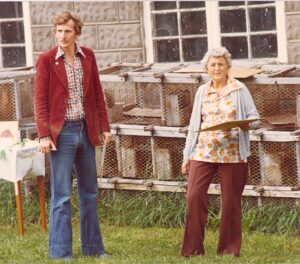
It´s part of the deal that, as a judge on a Borzoi-Special, you are expected to sum up your impressions and the decisions you make during the assessment. afterwards. This year I was invited to judge BorzoiRingen Västra’s Tånga Hed show, which I happily accepted. I will come back to that.
Having reached the years that makes one be placed in the veteran class, I started counting in my head and came to the conclusion that it would be the eleventh time I had the opportunity to express opinions about the dog breed I devoted a large part of my life to.
My thought then was, that as long as my mind and memory are still reasonably intact, I will take you on a journey back in time, and make a summary of the referee assignments I have had.
My premiere was made on a sunny August day 1977 in Floby. In good company, there was a panel of judges consisting of Harriet Jäger, kennel Odessa, Gunnar Larsson kennel Don-Cosacken, so I was in good company. The exhibition was held at Carina & Clas Janson’s kennel Tovaristjś, with scoring according to an established protocol.
15 dogs attended and when the protocole was collected, and compiled by our secretary Maud Lundvall, it was LeiCros Zilla (Ch Daragoj Wascha-Ch Ninotcka), that collected the most points.A result that pleased me. (I always had her as a personal favorite.)
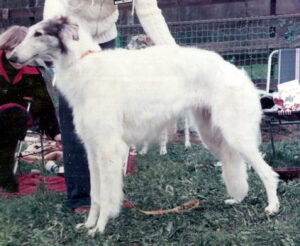
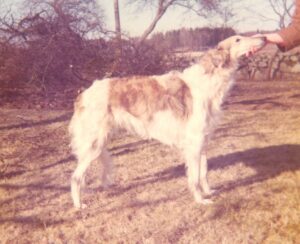
Second was another bitch, Dobre-Dzenia (Tzars Gordy-Borzaja) bred by Karl Kolschen, a little inconspicuous, but with great breed type and correct details, which gave high scores from all judges.
My next assignment was in 1981, Gusselby, where we visited Maud Johansson and Peter Frost-Olsson. There were about thirty Borzoi entered. I had some butterflies in my stomach, because as a judge you don’t just write your own criticisms, you also have to be prepared to face criticism and questioning. I had also decided to hold an “open judging”, i.e., orally justify my placements, something that at the time was encouraged by SKK in its referee training, I remember that the then newly graduated Kenneth Edh, blessed in memory, at least during his first years as a judge, embraced this.
I found my best male in LeiCros Russian Zmart, a son of the previously mentioned LeiCros Zilla. A well-built and -bodied Ch male. Today’s great joy I found in the bitches open class, Invibe’s Achenka, two years old, who I believe made her show debut here. Achenka was one of 10 puppies of Inger and Åke Bengtsson first litter, a litter that had five Ch-s. Achenka later became one of them and they were all given the kennel name Invibes. Achenka, owned by Inger Andersson, is still one of the best bitches I have met in my years. Great, low, reachy movement, and a type of Borzoi I just love. I had no major concerns when I made her BOB.
In honor of the day, was it also the Swedish premiere? for an impromptu Lure-Coursing, in fairly simple form, a sled hare being driven straight ahead for just over 100 meters, but still a dawning start to what is now an official working test for the breed.
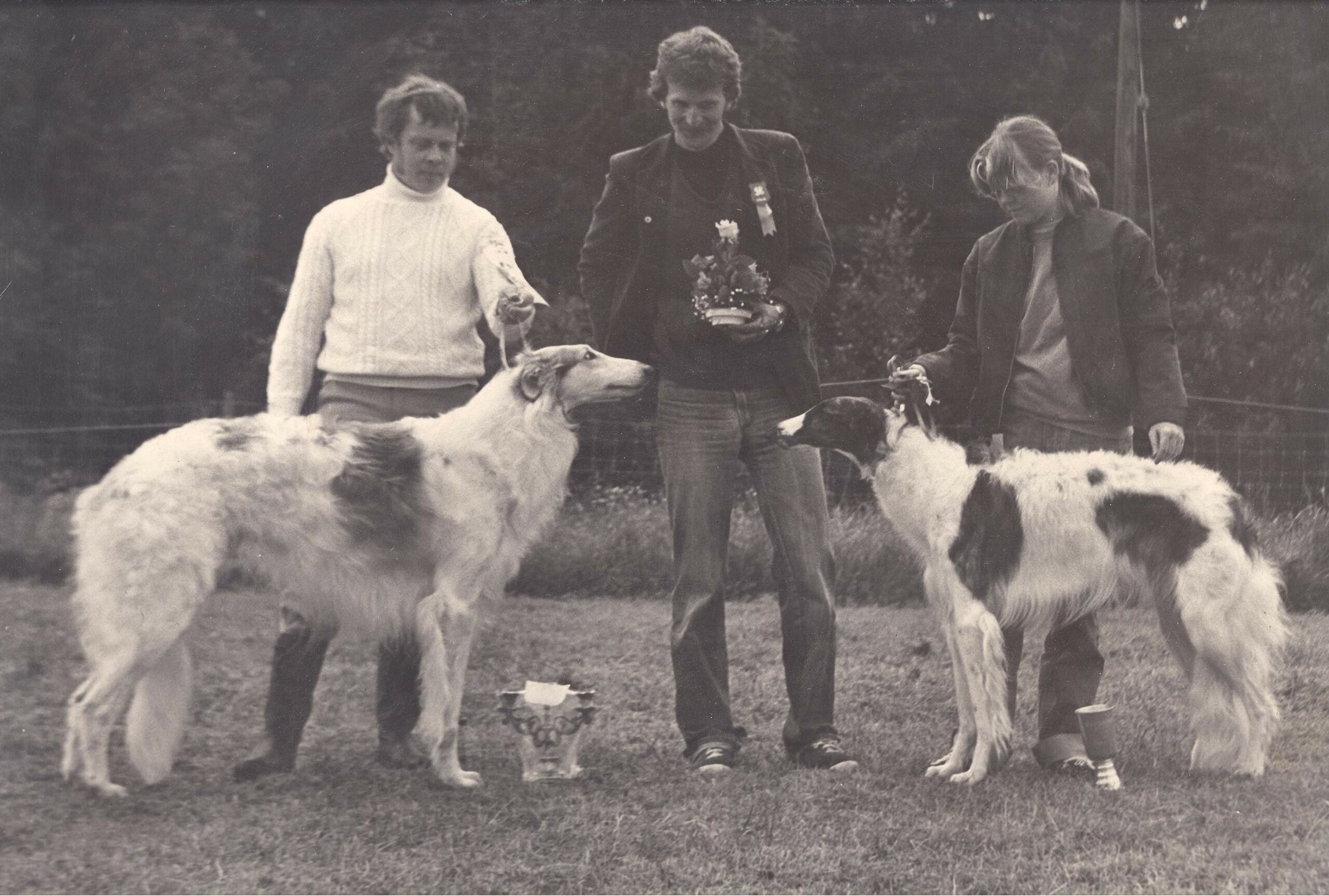
My next assignment as a judge took me outside the country’s borders. In 1984 I was invited by the “Norska Myndeklubbens Borzoiutvalg” to judge their National Special in the Oslo area. My knowledge of the state of the breed, the other side of the Svinesund Bridge was quite limited. Borzoi as a breed had disappeared in Norway during the Second World War, and was resurrected in a real sense when Fritiof Aamodt, in the early 1960s, restarted his kennel Frimodt’s. The breed was then built up mostly via Swedish and Finnish imports, in order to stand firmly on its own base during the 1980s.
38 registered Borzoi was a high and gratifying number, so I went to work with great pleasure.
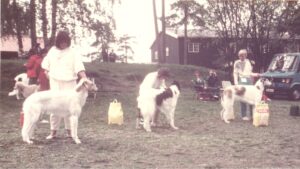
Saw a lot of nice Borzoi there, one Al Wintar’s United Astrachan, a major winner in the making. There were four Ch males on ground, the winner was Swedish-born Za-Wados Tzarkow (Ch Al Wintar’s Mirjoz Wlademir-Ch Silverliden’s Waar-Zaava) whom Anne-Lise Wintar had brought home as a mating puppy from breeder, Anita Bayoumi. A solid, well angulated and nicely coated male, not the best movements of the day, but a dog of fine type.
However, he had to stand back for my female winner, also I would learn, Swedish-born. Yablonaja Dvirna (Ch LeiCro’s Russian Zadhel-Barsajas Irina) was her name, a very attractive lady, excellently shown in fine condition, and a lot to like, a long elegant head and the best movements of the day were a couple of them.
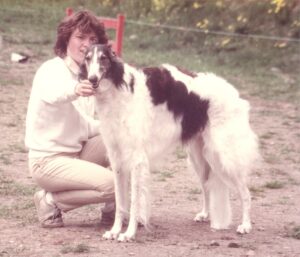
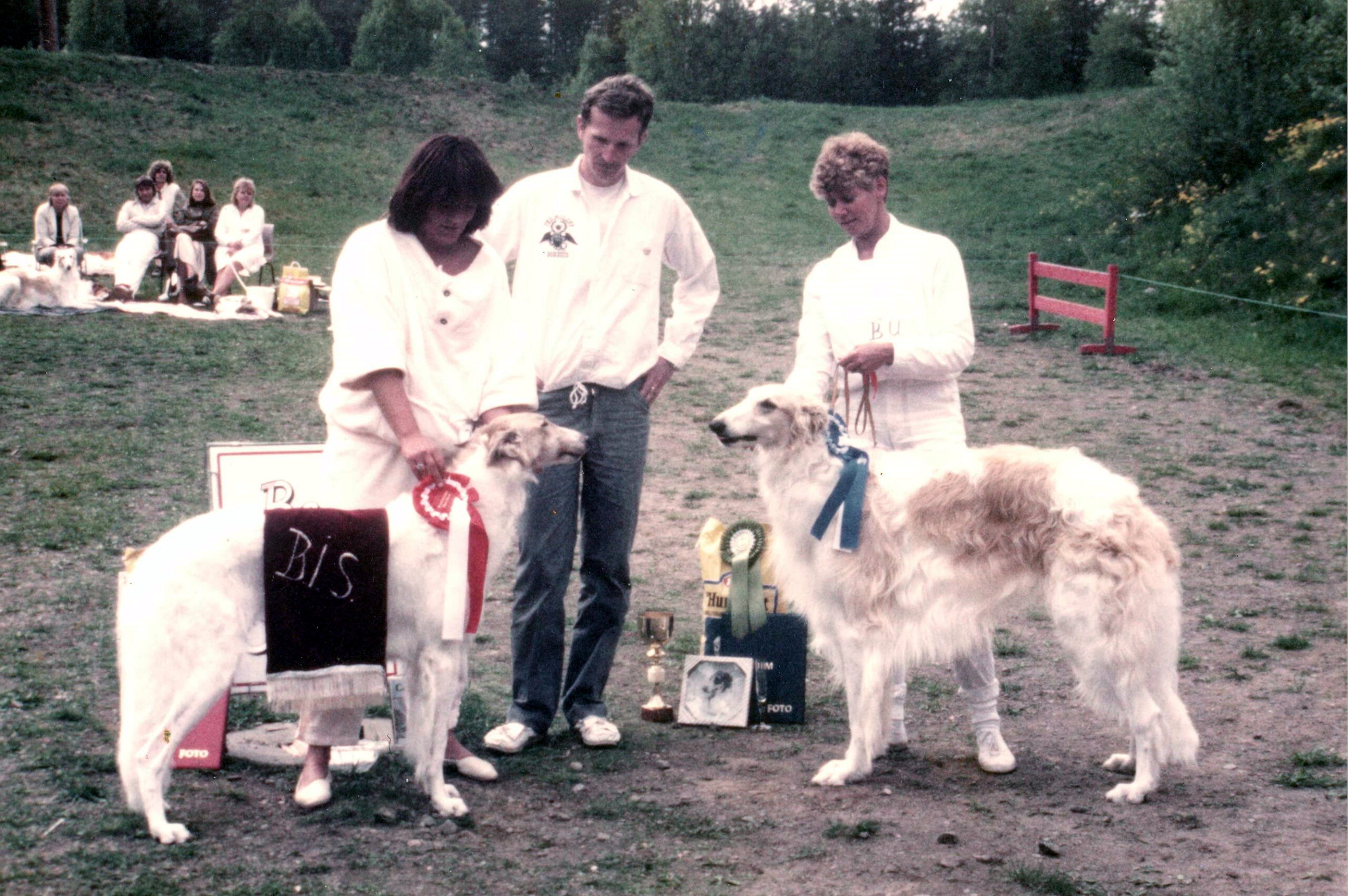
If I had only judged the breed without moving them, the veteran bitch Al Wintar’s Maruska would have won easily, she now became Best-bitch-2, after her 5-year-younger competitor.
As a parenthesis, it can be mentioned that Harry Zuber, Borzoi specialist from Switzerland, the next day made my BOB winner Best-bitch-2 with certificate, after Ch Invibes Azokova, (litter sister to Achenka, BIS in Gusselby) Azokova did not participate at the Special. Best Opposite, again Za-Wados Tzarkow.
In 1987 it was time for my next judging assignment, this time on home ground. BorzoiRingen Västra invited me to judge their Slottskogen open show, in the middle of Gothenburg. A different experience, as this time I was quite familiar with both dogs and owners, something that had to be disregarded when the show started. A brief, general summary of the show would be that the quality and size of the dogs shown showed a wide range, some males had grown to fast, and needed time to grow into the suit, while many of the bitches were close to the lower limit of the standard in terms of size. In my judging, I always look for a combination of type, and soundness in construction and movement. In the Senior class (over 7 years) I found the one that best combined these qualities, Int Ch Tovarisjtj’s Jewel (Ch Yermoloff’s Rasboi-Ch Tov. Mazeppa), I wrote “It is hard to close your eyes to his faults, a little long back, which over the years has tended to “flatten” more and more, however, it is even harder to ignore all his credits, size, male character, excellent coat, and his unique showmanship, with movement that none of the younger dogs not even came close to, add to this his excellent temperament. Thus, no difficult choice to place him first among the males although type wise preferred his son, shown in the young dog class, Zhivago´s Czardas (Tov. Jewel-Ermolaijs Fedra-Ferim), a very high class Borzoi, but in movement he had to stand back to his father.
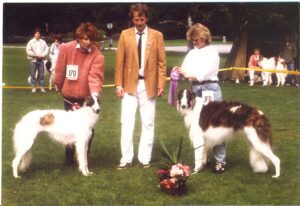
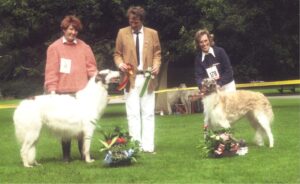
Among the young bitches was a daughter of Jewel, Tovaristj´s Terezia (Tov.Jewel-Tov. Czardasfurstinnan). She had similar qualities to her sire, but was beaten in Best bitch class to Champion Don-Cosacken’s Maritza (D.C Czardas-D-C Kaljinka), a bitch with fantastic type and breed details, a bit weak in hindquarters, but with perfect side movement In BOB, she was beaten by Jewel.
1988, it was time for me to judge Södra’s Svalöv show. Sunny weather and a nice entry would make it a pleasant day in south of Sweden. The quality of the dogs were uneven, In a couple of classes I didn’t find anyone worthy of Honour Prize, but there was also some of high quality in other classes. A young male that caught my eye was Mysjkin’s Tehrazow, big and with nice movement from the side, but needed more firmness in the rear. I found my best male in the Ch-class, a son of Tovaristj´s Jewel (he was widely used for breeding during the 1980s) Akzinja´s Aksakov, owner/breeder Siv o Knut Persson who had inherited a lot from his father. his movement was just nearly as impressive. Among the bitches I found quite a few that appealed to me, a junior from kennel Yablonaja, Nablona after US import Windhounds Bea Brave was a nice acquaintance.
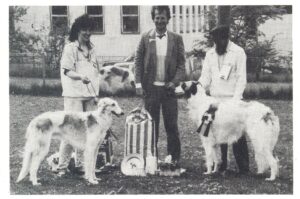
The bitch that appealed to me the most came from the young dog class, Mysjkin’s Troyka (Ch Boris-Thinka) owned and bred by Ulrika Lindström, line bred from two Majorow’s siblings with a quarter Russian blood. She was not yet fully matured, but the way she moved really illustrated the US breed standards slightly lyrical description “The overall appearance in motion should be that of effortless power, speed, agility, smoothness and grace”. When she moved, all this was summed up in Troyka, In BOB she had to give in to the male, equally excellent mover, and also more matured.
In 1993 I received an invitation to judge Norra Norrland’s first exhibition. It’s a bit of a drive to Piteå, but at the same time it would be fun to see what Upper Norrland had to offer of Borzois. Brilliantly beautiful weather on the day of the show, 19 Borzoi entered doesn’t sound like much, but in light of what the SKK shows gather at these latitudes, it was still a respectable figure. Among the starters was found a nice junior bitch from kennel Sahejeev’s which I predicted could be a good addition to the breeding in this part of Sweden. (If that happened I don’t know?) As usual, there was both wine and water among those entered, some unfortunately with insufficient angulation in the front. The fact that some veterans were not so active in movement can be blamed on the summer heat. I also found some very good Borzoi, both well constructed and with lots of breed type. Two Champion males entered, where the still young, Ch Timirinja´s Birkovitch (Polongain Jura-Don-Fursteevas Czarina) drew the longest straw. I thought he reminded me of some of the Swedish dogs you saw in the 1970s, so when I afterwards checked his lineage I was not surprised to find Don-Cosacken, as well as Majorow and Murugi dogs behind him.
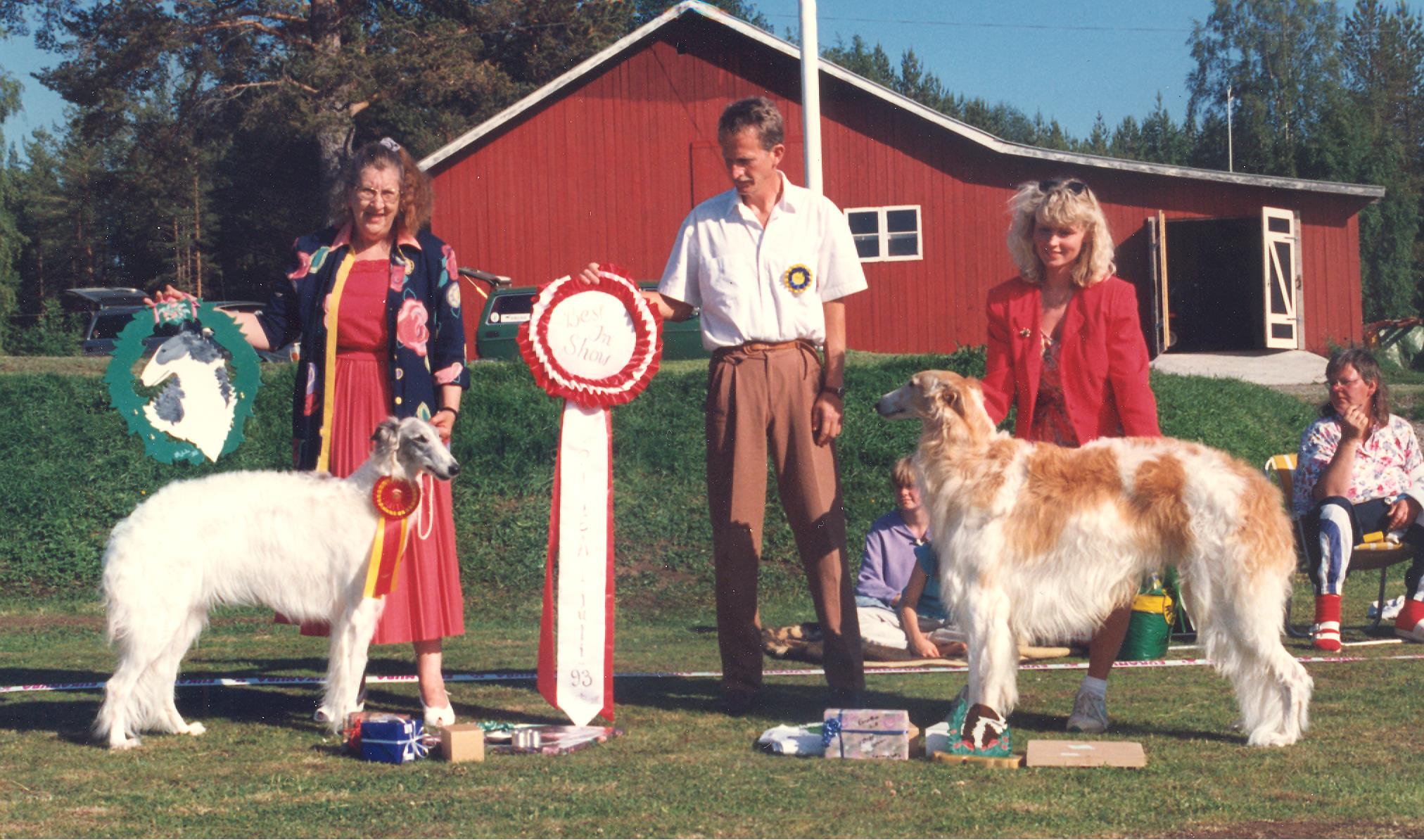
It was among the four in bitches open- class, I found another eyecatcher, a mere 2-year-old show-debuting bitch, Carats Rodnaja (Ch Ochotniks Setjas-Carats Olitka). She was quite easily placed as a top bitch, with all the breed details in place, and of delightful type. (do remember, that against my innermost principles, I advised the owner to trim off her underline a bit) Thus, in the meeting about the BOB rosette, I had a hard time choosing between “Birk” and Rodnaja. Both moved very nicely from the side, but they also both showed some to remark on, the male with a slightly to much bent middle hand and also moving a bit tight behind, the female slightly inregular in front action. In the end I chose the one that was closest to my heart, in terms of type, so the bitch got the (giant) BOB rosette. She was owned and bred by Vivi-Ann Löfgren, to whom I would like to give a posthumous eulogy here for her many years of successful work with the Borzoi in this part of the country.
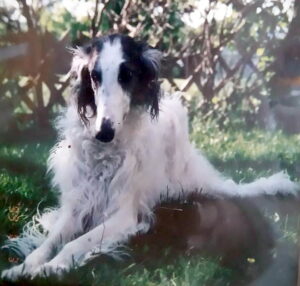
In 2000, in Förslöv, Skåne, at the home of kennel LeiCro, the Borzoi Ring had resumed the old-time 3-judge scoring. Similar criteria as before, regarding the composition. That is a judge authorized in the breed, an experienced breeder and a slightly more inexperienced one.
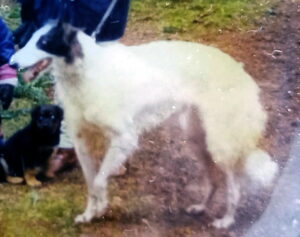
This year’s judging panel then consisted of Tina Permo, SKK judge, myself and Noa Håkansson, who was new as breeder, but since she was daughter at Eva Håkansson’s kennel Sahejeev, still with lots of experience and knowledge. The outcome here was similar to that in Floby 23 years earlier. It was the inconspicuous older bitch (see Dobre-Dzenia) collecting a high score. The nine year old Roma (Ramalon’s Dolochov Romanowa-Yermoloff’s Romaschka)
Although these bitches probably wouldn’t reap any big harvests at today’s shows, when showmanship and skillful handling usually are whats most important, I still think this is an activity that Borzoi.Ringen, as an association for the breed, should resume. If you want to preserve a breed, it is the details that make up the whole. Then it must be a primary task to educate both breeders and judges of what is important, and what is special about the Borzoi breed.
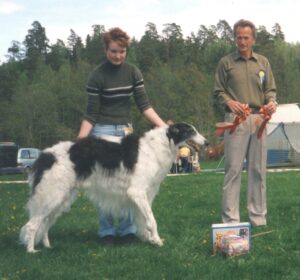
The millennium year 2000 also meant an invitation to B-R Östra’s Pilsbo exhibition. A very beautiful exhibition site, and a sunny day provided great conditions for a nice exhibition. Due to rampant kennel cough, the number of registrations had shrunk to a modest 22. The consistently good quality of the participants led to a certain decision anxiety in some classes. The best male class came to consist of 5 Champions, one of them from the Veteran class.
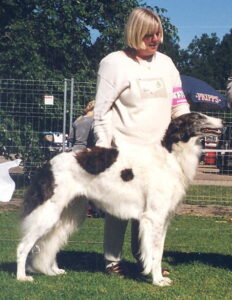
He was the one that appealed to me the most in terms of type, Yablonaya Uspenski, lovely size and shape, his age contributed to the fact that he could not measure up in movement with the younger dogs, but it was still enough for a third place. The winning male was the Ch Ardagans Yondalar (Ardagans Warlock-Flavia de Tchesskaia) imported from Holland
Among the bitches it was no less easy to choose, a strong open class, where I still could pick Borzowski’s Penelope Pepper (Ardagan’s Yondalar-Stravi Magdalena) for first. She had an amazingly fine topline, from neck to tail, and moved very well.
Among the Ch-bitches, I also found one that was close to my heart. Tarasov’s Chenya Clarissa was in fantastic condition, hard muscled and with fine details. When it came to the B-T class, however, she had to give way to youthful freshness. “Pepper” became Best Bitch, and then just beat her sire in the BOB, where her details and movement decided the outcome.
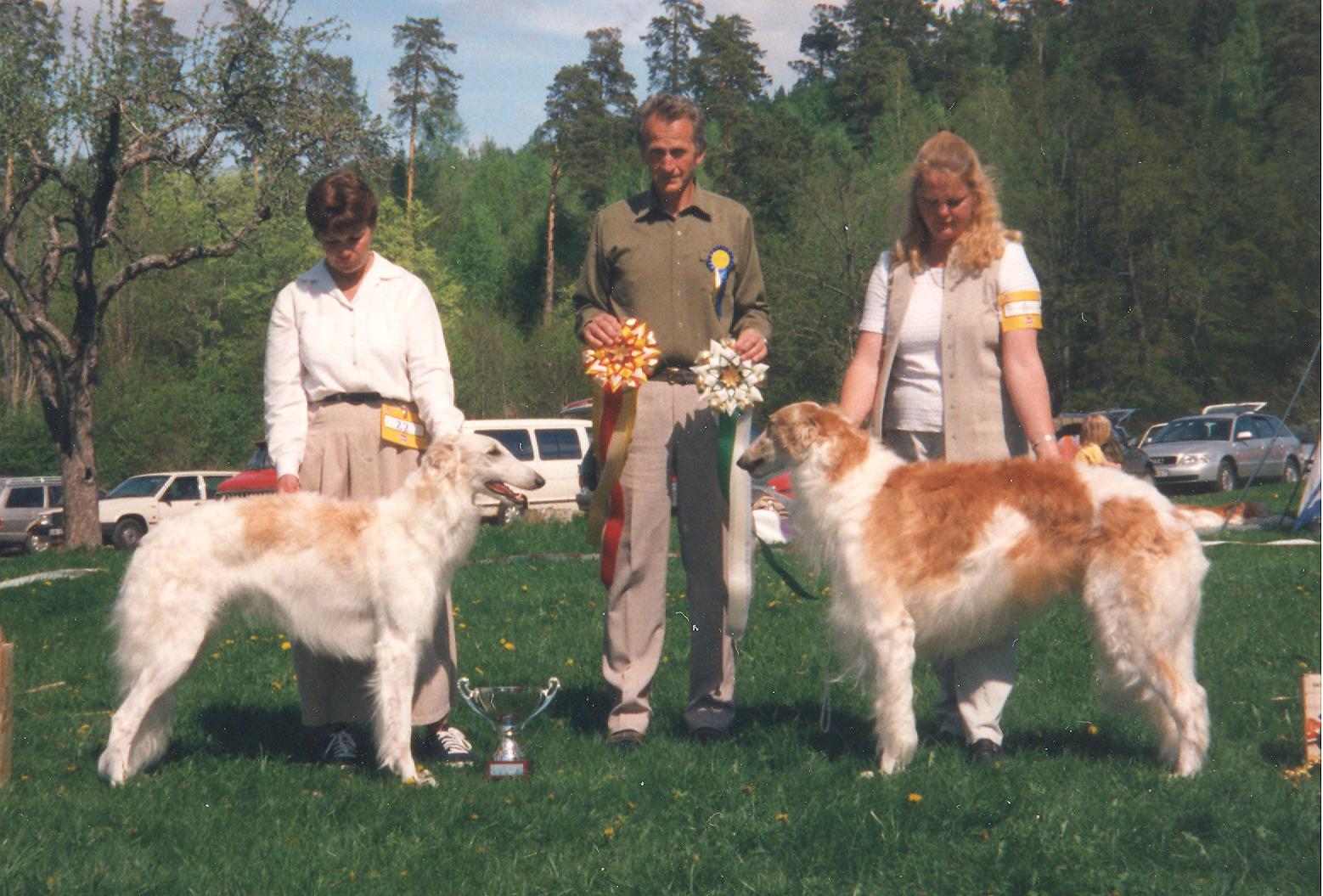
In 2003 it was time for a longer journey. By air to Glasgow, then hire a car to Whitby, a coastal town in Yorkshire, where our hosts, Jean & John Leyland-Quarmby recently had moved. The exhibition was to be held at the Grenoside Community Hall, just outside the steel city of Sheffield.
English Borzoi have always been close to my heart, the first Borzoi I met in my life was Signe Hallqvist’s Ch Sadia of Whitelilies, and swedish Borzoibreedings most common additions in the years between 1950 to 1990 were dogs from England. I have personally contributed with three, first Falconcrag Mirja, later Ch Saringa’s Cognac and Sholwood Sweet Mahoonia.
A little extra edgy with this mission. My intention was that even if the English breed standard differs from ours, I will stick to my own yardstick and the standard interpretation I have learned to apply over the years. Won’t go into too much detail, just mention the dogs that lasted in my memory.
There were two nice older puppies from the Ryazan kennel.
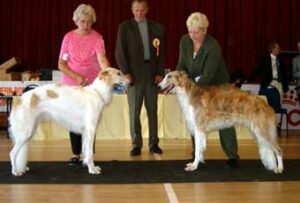
I liked the male a lot, but he was a bit smaller than what I want to see a male. The bitch was also nice, but a little upright in the front, noted that was a common fault in the dogs shown that day. The vast majority were of a wonderful type, with beautiful heads, but sadly many were not that good in movement. The male I liked the most was from J. Tutton, Vashla Vladika (Vashla Vranac-Vashla Vectra. He was well bodied, nicely constructed, harmonious in angulation and movement, perhaps not as beautiful in head as most, but still ok.
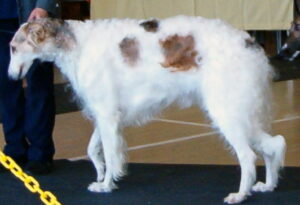
Among the Graduate bitches there were a very nice, Randas Ballerina, of classic type with fine details, but she too missed in movement.
By far the best movement of the day was a Junior bitch from Roger Heap, Rae Veronica(Sweet William-RaeLotti Mae ) She had more than movement, beautiful topline and harmonious in angulation as well as a correct bitch shape, i.e. a little longer than she was tall. She became my best bitch, and in BOB her movement schedule was enough to win, probably to the surprise of many. My thought at that time and moment was, if correct movement is rare, one must take care of those who have that quality.
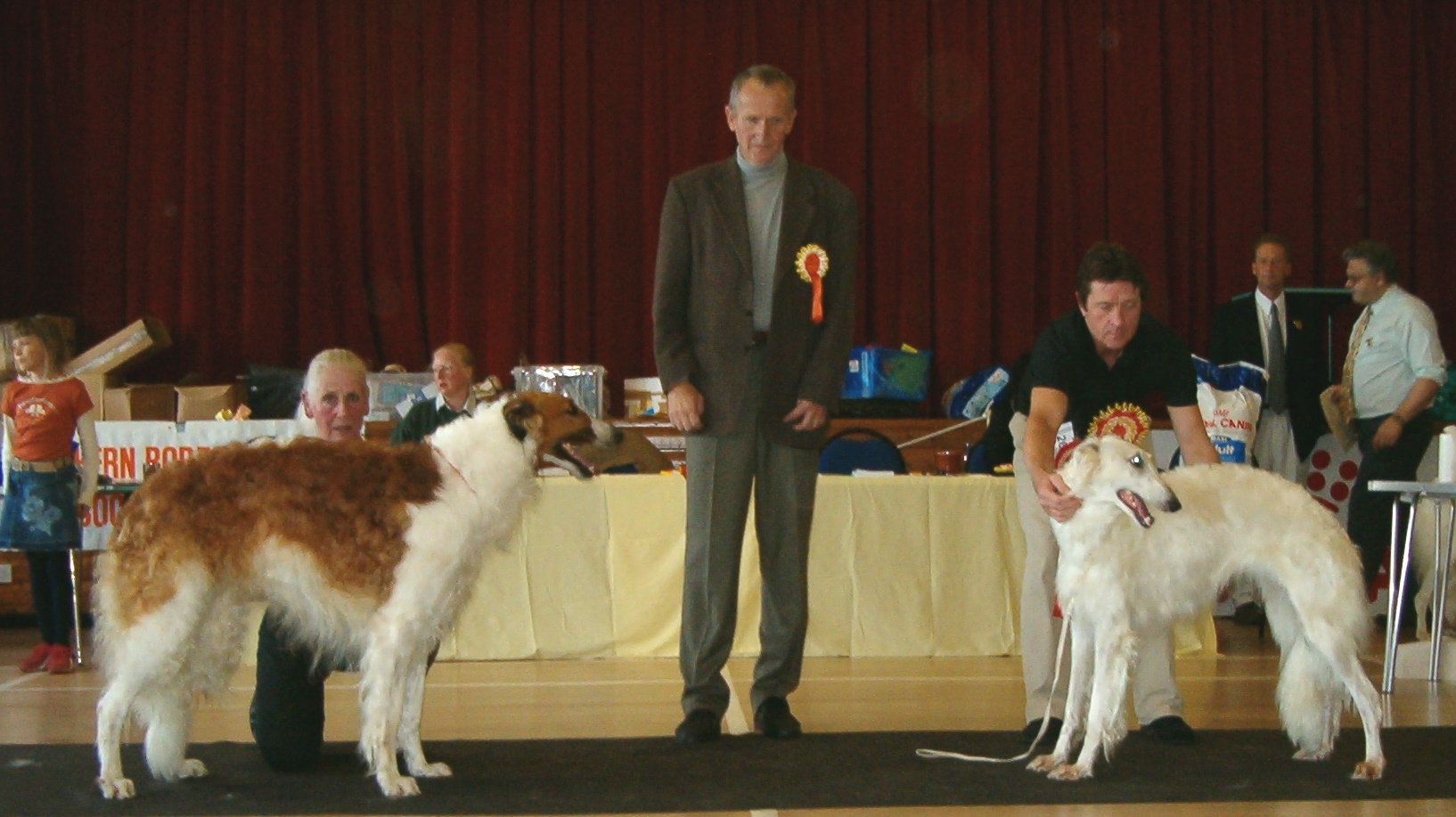
My next referee assignment was on familiar ground. In 2010, B-R Västra invited me to judge their Tånga Hed exhibition. I have read through the comment I wrote after that show, if I had previously given high priority to race-typical movements, I had decided, at least in part, to put first priority this time on one detail, which I had observed in several generations of show winners, really held about to become a scarce commodity. The Borzoi’s hallmark, the gently arched back, especially in the male dog. The bitch can have a flatter topline, but it does not mean that it should have it. Since this continues to apply, I will quote the text I wrote in 2010.
“A correct Borzoi males’s topline should start at the shoulder, to reach its highest point above the last rib and end with a gentle curve down over the loin and croup. It is extremely important that the upper line forms a smooth line, as painted as an artist’s sweeping brush strokes. To observe is that this arch must absolutely not tend to become a carp back, nor have the highest point at the shoulder to end with a steep cross. In my opinion, the American version is also not desirable, i.e. a back that is flat up to the midsection, to end with a small “hump” over the loin.”
It was with this in mind that I began my mission. Once again a day with beautiful weather, good registration numbers, and many nice dogs. Already in the male Junior class I found a gem, Jelistaz Thriller (Jelistaz Omar Sharif-Indian Cherokee Modnayabistru) with a lineage dominated by Scandinavian lines, but also a quarter of classic English, with a grandmother from kennel Vronsky. It was a dog that I had a hard time to remark on, his topline was exactly as I have described that it should be. The only (petty) remark I had was that his middle hand would have more slack. After watching Thriller, the other males faded a bit, but there were several very good ones. Among the bitches, I thought the best of the day, was an open bitch, which I don’t think has been shown to any great extent, nor sooner or later. This is how I described Chernak’s A Passion for Mining in that occasion “A bitch that has the most of it, power, elegance and sound movement in a nice combination, which meant that I had no problem to overlook some premolar missing. In the battle for BOB, it was Thriller who drew the longest straw, with the justification that he embodied the special air of “Noblesse oblige” that a first-class Borzoi should radiate.
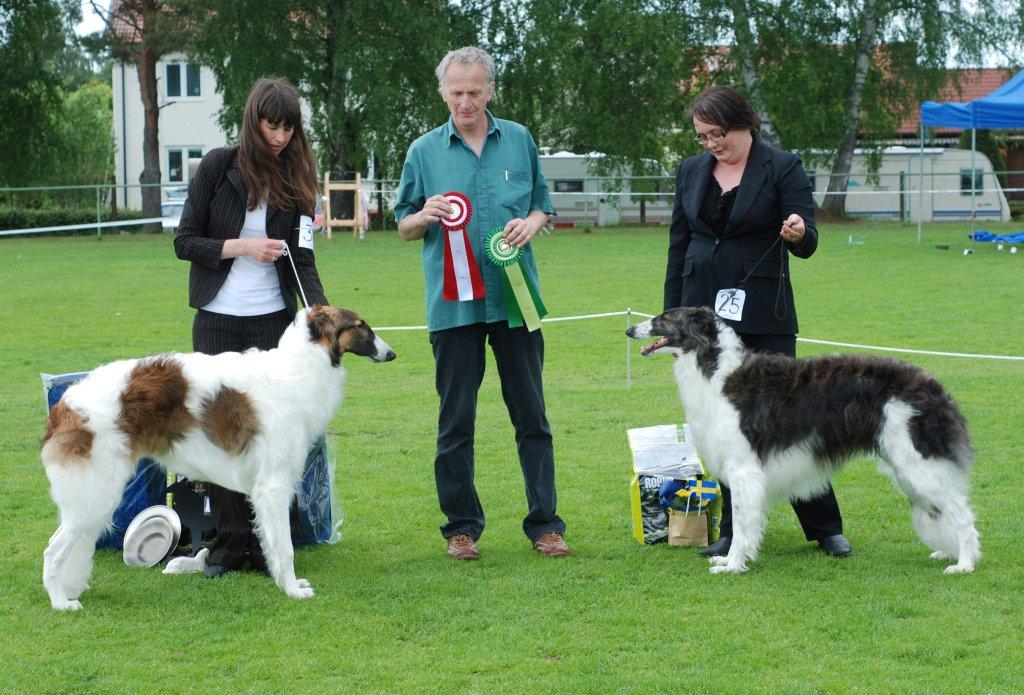
Another important point, to add to what was said above about topline, is that in the standard I learned, it is stated that a male Borzoi should give an almost square impression. only be slightly longer between the tip of the withers to the sacrum than it is high at the withers. A bitch should be slightly longer, this is to some extent dependent on the length and construction of the back, but also the length of the dog’s legs in relation to the length of the back. Looking at photos of today’s winners, very few male dogs meet these breed standard criteria. Since those who judge our shows only have a superficial knowledge of most of the breeds they judge, we cannot solely blame the lack of well educated judges. (in parentheses it can be mentioned that as far as I know, there is today only one judge in the Nordic Countries that have a background in Borzoi) The responsibility must be placed on those who breed. That only specimens that fulfill at least the most important points in the breed description are chosen, and that it is the responsibility of the Breed Club to offer all newly graduated judges, an opportunity to go through the breed description, point by point, together with experienced breeders.
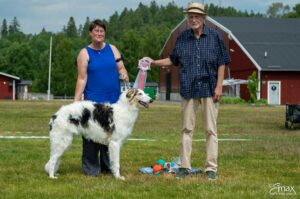
So, now 12 years later it was time to return to the “scene of the crime”
Tånga Hed 2022
This Midsummer day offered brilliant sunshine, so hot that it was feared that there would be difficulties for the dogs. Now it didn’t turn out that way, light clouds softened the heat, and everyone seemed to enjoy themselves, including me. It was a familiar atmosphere, most people present were from western Sweden, so I met a number of familiar faces.
A puppy entered, Schestaya’s In Between Days was a nice, almost nine month old male, overall a nice acquaintance My only comment was that the loin could be a little longer.
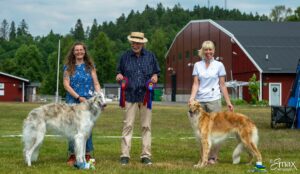
In the male Junior class there were two starters, both got HP, I was particularly pleased that both had good size and shape. The first placed, Hagabergslide’s Chasing A Vision was sharper in the details.
Then came the young dog class with three starts. Today’s great joy for me, when I found here a male whose model and appearance reminded me of the role models of the past. Sergai Frisia Pascholl, Mythe Mazeppa and Borsjanas Alex all appeared before my mind.
Bierioza’s Paj-Cho was the name of this marvelously fine male, where I could really list superlatives in my criticism. Excellent size, wonderful head with many fine details. Beautiful coat, correct shape and a sweeping backline finished with a long, low-carried tail, he was radiantly beautiful, both standing and moving.
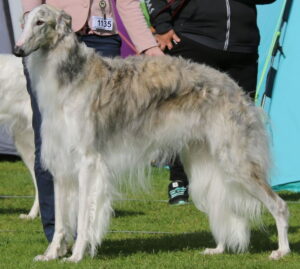
Second here was his litterbrother, also very nice, but not quite with that little extra in the details, what separates the chaff from the wheat. Even the third was a pleasing Borzoi, with good details overall.
Open had two starts, the first, Vatthalia’s Sir Lancelot, was a very well-furred, strong and nice dog, but unfortunately lacked a bit of the elegance that should distinguish a really good Borzoi.
The Males’ Working class had one participant, Russkaya Zabawa Faraon who was a Borzoi of good shape and details with ok movement.


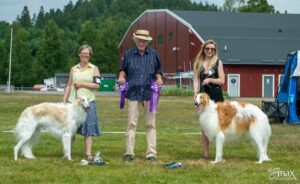
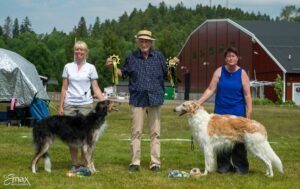
In the champion class there were three really good dogs, all got Honourprize. Had a bit of a hard time distinguishing between one and two. The second was a solid, imposing male dog with lots of fur, and the same can be said for the first. They were equal in movement, what separated them was topline/format, with the one, Kazar Zamir best matching the standard’s requirement of an almost square format. One starting Veteran male, Chernak’s Texas Holdem. Good shape and ok topline, but slightly sloping in the croup, movements were what you could ask for from an older dog in the heat of summer.
One start in the bitches’ Junior class, Hagabergsliden’s Chasing A Dream, a very promising girl with a nice future ahead of her. Fine details and topline, good format and movements.
In the bitches’ young dog class, there were two high-class youngsters. Both with excellent heads, fine details, beautiful toplines, good shape and movement, hard to tell them apart. The one placed first, Bieriozka’s Shkara had a bit more flare, so that made my decition.
The bitches’ open class was also very pleasing with four very beautiful representatives of the breed. I saw my winner, Chernak’s Rolling The Dice, 6-7 years ago as a puppy at a Breed Special in Landskrona and was at the time completely captivated by her. A bitch that is incredibly balanced, with fine details and good movements, I should remark, a little more coat and size would complete the picture. The other three also held a very high standard, all of them could go high in competition with the best.
The Bitches’ Working Class had a start, Bierioza’s Biela was a bitch of excellent type, good size, movement, and fine details.
One starting, a very beautiful bitch, Hagabergsliden’s Laugh Out Loud in the Champion class, feminine, correct throughout, with nice movements.
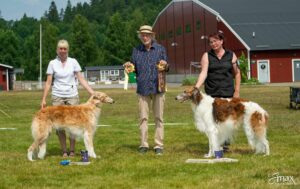
Only one Veteran bitch Bierioza’s Vesta was of a similar type as winner in working-class, with the same credits, very well preserved! The breeding group after Bierioza’s Biela later became Best in Breeding class.
In the Breeder class, there were pleasingly three participating groups. All absolutely excellent, but the one from kennel Bierioza still won quite comfortably, with four high-class dogs of the same type.

Then it was time for the BIS, the young male against the Ch-bitch, I had no problem to make my decision. In my eyes the male of the day was absolutely “outstanding” in any competition, he got a comfortable win.
It was a very nice exhibition in many ways, what particularly pleased me was the lack of males with flat and excessively long backs, on the contrary, several with very fine upper lines with sweeping lines. One thing that generally bothers me among today’s dogs, however, is that I miss those movements that almost take your breath away, a first-class Borzoi will float, a couple of centimeters above the ground, with long sweeping steps, seemingly without the slightest effort.
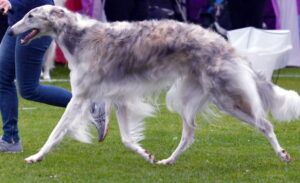
As an English breed specialist once wrote “I could have been standing there for hours, just watching him move…”
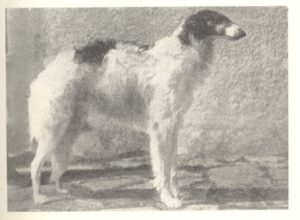
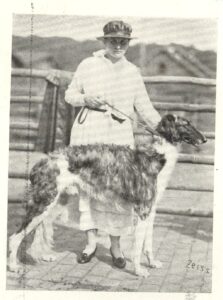
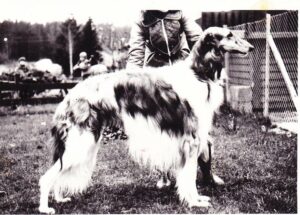
Dan Persson
,
Year of Event:
Country:
Personal Collections:
Source:
Author:
Dogs:
Persons:
